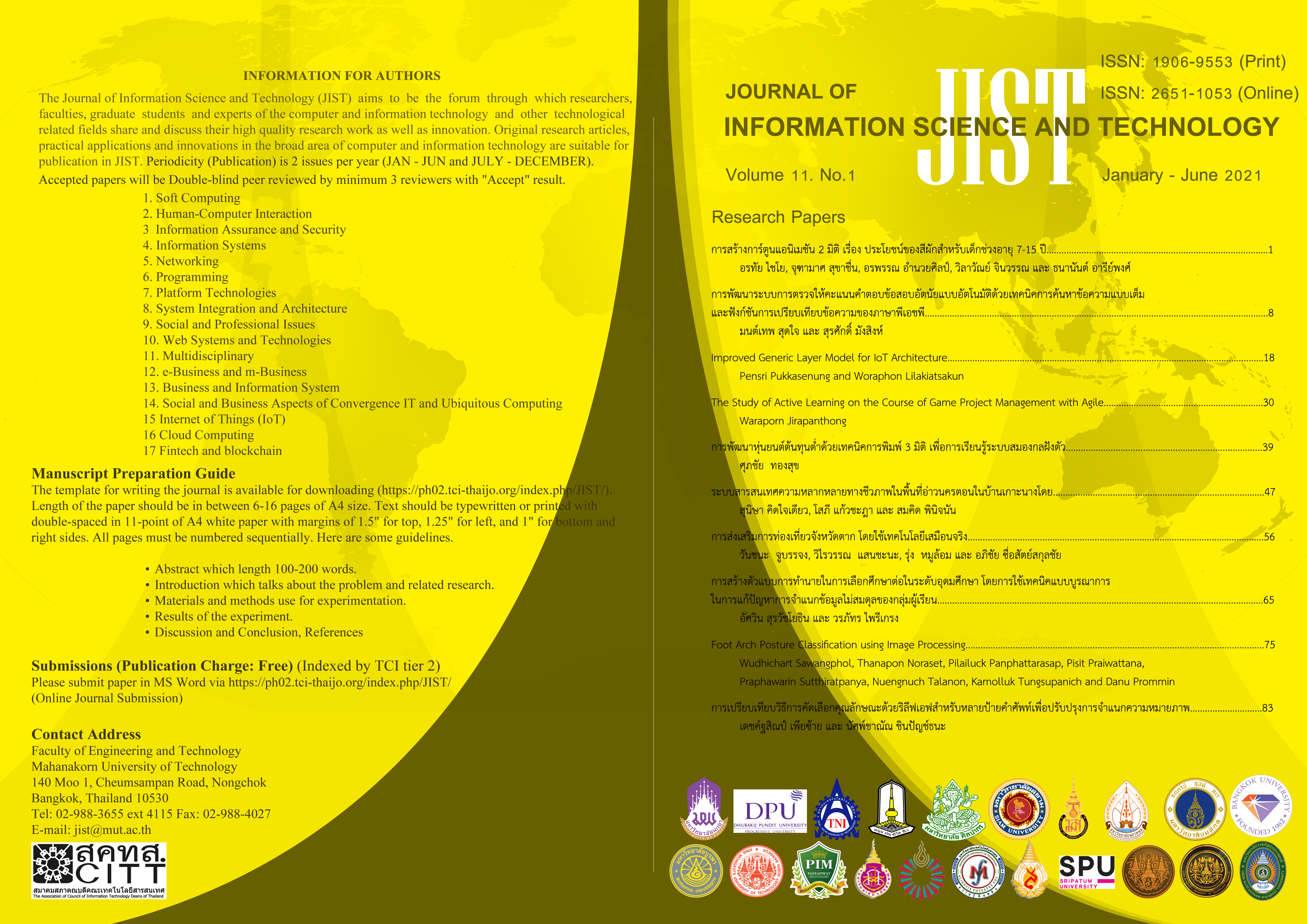Foot Arch Posture Classification using Image Processing
Main Article Content
Abstract
The foot arch is a key role in supporting the weight of the body and providing propulsion force during push-off, it enables a more natural and aesthetic gait and protects the foot from injury. An effective way to prevent injuries caused by abnormal foot arches is to use suitable personalized insoles. Personalized insoles can reduce and relieve the pain that caused by abnormal of the foot arches, which can be difficult to make for each particular type. Current methods of analyzing foot arches are manual calculation, which is time consuming and prone to human error. Therefore, the objective of this study is to classify foot arches posture and determine different foot arch types based on the foot scan image by develop an application to improve the analysis of personalized insole. As the result, our foot arch type classification gives the satisfied result at 87.5% comparing to the data classified by expert.
Article Details
This work is licensed under a Creative Commons Attribution-NonCommercial-NoDerivatives 4.0 International License.
I/we certify that I/we have participated sufficiently in the intellectual content, conception and design of this work or the analysis and interpretation of the data (when applicable), as well as the writing of the manuscript, to take public responsibility for it and have agreed to have my/our name listed as a contributor. I/we believe the manuscript represents valid work. Neither this manuscript nor one with substantially similar content under my/our authorship has been published or is being considered for publication elsewhere, except as described in the covering letter. I/we certify that all the data collected during the study is presented in this manuscript and no data from the study has been or will be published separately. I/we attest that, if requested by the editors, I/we will provide the data/information or will cooperate fully in obtaining and providing the data/information on which the manuscript is based, for examination by the editors or their assignees. Financial interests, direct or indirect, that exist or may be perceived to exist for individual contributors in connection with the content of this paper have been disclosed in the cover letter. Sources of outside support of the project are named in the cover letter.
I/We hereby transfer(s), assign(s), or otherwise convey(s) all copyright ownership, including any and all rights incidental thereto, exclusively to the Journal, in the event that such work is published by the Journal. The Journal shall own the work, including 1) copyright; 2) the right to grant permission to republish the article in whole or in part, with or without fee; 3) the right to produce preprints or reprints and translate into languages other than English for sale or free distribution; and 4) the right to republish the work in a collection of articles in any other mechanical or electronic format.
We give the rights to the corresponding author to make necessary changes as per the request of the journal, do the rest of the correspondence on our behalf and he/she will act as the guarantor for the manuscript on our behalf.
All persons who have made substantial contributions to the work reported in the manuscript, but who are not contributors, are named in the Acknowledgment and have given me/us their written permission to be named. If I/we do not include an Acknowledgment that means I/we have not received substantial contributions from non-contributors and no contributor has been omitted.
References
Z. Mei, K. Ivanov, G. Zhao, Y. Wu, M. Liu, and L. Wang, “Foot typeclassification using sensor-enabled footwear and 1d-cnn,” Measurement, vol. 165, pp. 108184, 2020.
Y. M. Golightly, M. T. Hannan, A. B. Dufour, and J. M. Jordan, “Racialdifferences in foot disorders and foot type,”Arthritis care & research, vol. 64, pp. 1756–1759, 2012.
Foot and Ankle Clinic of the Virginias, “What are the risk of cavus foot(higharches)?,” Foot and Ankle Clinic of the Virginias. [Online]. Available: https://drfootpain.com/cavus-foot-high-arches-risks/. [Accessed: Jan. 20, 2021].
W. Morrison and A. Felman, “What’s to know about flat feet?,” Healthline Media UK Ltd, 2018. [Online]. Available: https://www.medicalnewstoday.com/articles/168608.php. [Accessed: Jan. 20, 2021].
G. S.Murley, H. B.Menz, and K. B.Landorf, “A protocol for classifyingnormal-and flat-arched foot posture for research studies using clinicaland radiographic measurements.” Journal of foot and ankle research, vol. 2, pp. 1-13, 2009.
M. S. Jian, J. H. Shen, Y. C. Chen, C. C. Chang, Y. C. Fang,C. C.Chen, and W. H. Chen,“Cloud image processing and analysisbasedflatfoot classification method,” International Journal of Computers, vol. 8, pp. 90-98,2014.
H. B.Menz, M. R.Fotoohabadi, E. Wee, and M. J. Spink, “Visualcategorisation of the arch index: a simplified measure of foot posture inolder people,” Journal of foot and ankle research, vol. 5, pp. 1-7, 2012.
B. J. Příhonská, “Analysis of foot typology in basketball players,” M. S. thesis, Masaryk University, Czechia, Czech Republic, 2018.
Python Software Foundation, “Python,” Python Software Foundation, 2021. [Online]. Available: https://www.python.org/. [Accessed: Jan. 20, 2021].
M Grinberg, Flask web development: developing web applications with python, O’Reilly Media, Inc., 2018.



